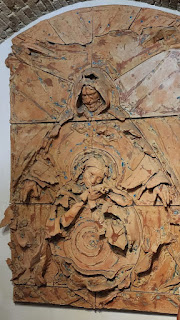Our Lady! So much to learn from!
If someone offers you something you have no clue about, do
you say yes right away or “no thank you?”
Dialogue to me has been, not only talking to the other
person; but most importantly, what is my position at that point in time? What’s
going on inside of me, am I able to be present in the conversation, am I able
to get curious, ask questions, rather than judge, or say no, immediately?
The thing about dialogue is it’s relational. It makes it
very hard not to judge or look at (or look to) the other person; therefore, it innately
possesses a challenge to look internally within oneself. Bishop Farrell and
Monsignor Indunil made it clear that we need to know our own identity before we
can start a dialogue with the other.
Many friends posted about their visits to Assisi. Similarly,
this altar where St. Francis of Assisi prayed struck me the most. I felt a
sense of peace entering this sanctuary.
In the centre of this sanctuary is a sculpture of St. Joseph protecting the Blessed Mother while Jesus in her womb is depicted as an image of a circle of eternity yet fully present in the centre. My increasing devotion to Our Lady and her fiat to God’s will is a clear demonstration of Our Lady’s fully present dialogue with angel Gabriel. After being greeted as “Hail, full of grace” (Luke 1:28), Gabriel requests of her to bear the “Son of the Most High” (1:31-32). Our Mother asked the question: “How can this be, since I have no husband?” It shows Our Mother “was curious and enters more deeply into the conversation, expressing a willingness to grasp something holy and mysterious” (Kun, wau.org).
As a woman, Our Mother has not only been my intercessor, but
she has also become a role model to emulate with gentleness, humility, and
grace. I might not do it perfectly but I’m confident that I’m in good company to
help correct me in dialogue with each other. I just pray that I’m open enough
to receive correction with grace and humility while staying true to my identity.
Our Blessed Mother with Young Jesus at the Dicastery for Promoting Christian Unity





Comments
Post a Comment